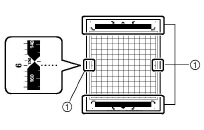The following procedures describe basic operations, from preparing the materials to cutting.
The recommended material thickness is 0.1 mm to 0.3 mm for paper and 0.2 mm to 1.5 mm for fabric. Refer to the following table for the appropriate mat and sheet for fabric cutting according to the material to be used for cutting or drawing. Depending on the machine model, some accessories listed in the chart may not be included. In that case, they must be purchased separately.
|
Material and its thickness |
Mat |
Sheet for fabric cutting |
||||
|
Standard mat |
Low tack adhesive |
Iron-on fabric |
High tack adhesive |
|||
|
Paper |
Printer paper |
80 g/m² (0.1 mm) |
|
|
|
|
|
Scrapbook paper (thin) |
120 g/m² |
|
|
|
|
|
|
Scrapbook paper |
200 g/m² |
|
|
|
|
|
|
Cardstock (thin) |
200 g/m² |
|
|
|
|
|
|
Cardstock (medium-thick) |
280 g/m² |
|
|
|
|
|
|
Vellum, tracing paper |
0.07 mm |
|
|
|
|
|
|
Poster board (thin) |
280 g/m² |
|
|
|
|
|
|
Poster board (thick) |
400 g/m² |
|
|
|
|
|
|
Fabric |
Thin cotton fabric |
0.25 mm |
|
|
|
|
|
Thin cotton fabric |
0.25 mm |
|
|
|
|
|
|
Flannel (for quilt piece) |
0.6 mm |
|
|
|
|
|
|
Flannel (except for quilt piece) |
0.6 mm |
|
|
|
|
|
|
Felt |
1 mm |
|
|
|
|
|
|
Denim 14 oz |
0.75 mm |
|
|
|
|
|
|
Others |
Plastic sheet (PP) |
0.2 mm |
|
|
|
|
|
Vinyl |
0.2 mm |
|
|
|
|
|
|
Magnet |
0.3 mm |
|
|
|
|
|
|
Sticker or seal |
0.2 mm |
|
|
|
|
|
 * When cutting smooth paper
* When cutting smooth paper

•This chart is only a guide, always test material and mat strength prior to beginning project.
|
|
Mat |
|
Sheet for fabric cutting
Use one of the following two sheets for fabric cutting when cutting fabric. |
|
High adhesive strength mat; use with cutting fabric. *Use the low tack adhesive mat with copy paper and smooth paper. Since the standard mat has a high adhesive strength, materials may remain stuck to the mat, causing the mat to become unusable. |
•Reinforces the fabric so that various patterns can be cut out. •The original texture may change because it remains attached to the back of fabric. *For use with the standard mat. *Do not place fabric backed with iron-on contact sheet directly onto a mat with high tack fabric support sheet. |
||
|
Low adhesive mat; suitable for copy paper and smooth paper. |
•For best results when cutting fabric, attach the high tack adhesive fabric support sheet to the standard mat in order to increase the strength of the adhesive. •Depending on the shape, the pattern may not be cleanly cut. •We recommend attaching it to a new cutting mat. |

•Avoid using materials covered with a decorative layer that can easily peel off, such as lamé or foil. Otherwise, the peeled-off layer may attach to rollers or sensors during operation, resulting in damage to the machine or to the cutting blade.
•Do not affix masking tape, etc., over the scanning marks. Otherwise, the mat may not be correctly recognized or images may not be correctly scanned.

(1)Scanning marks

•When using a 12" × 12" (305 mm × 305 mm) mat, the maximum work area for cutting/drawing is 11 3/4" × 11 3/4" (296 mm × 298mm).
•When using an optional 12" × 24" (305 mm × 610 mm) mat, the maximum work area for cutting/drawing is 11 3/4" × 23 3/4" (296mm × 603 mm).
•Some fabrics with uneven surfaces can be cut if turned upside down.
































